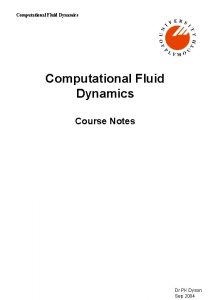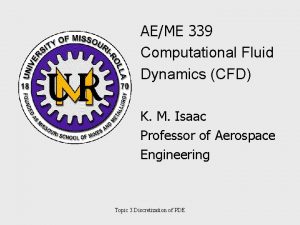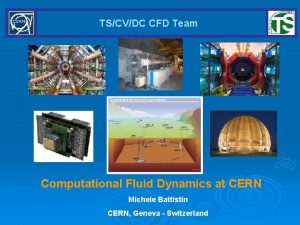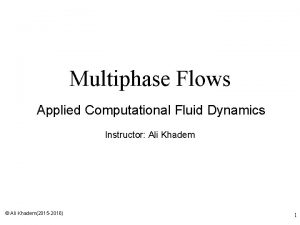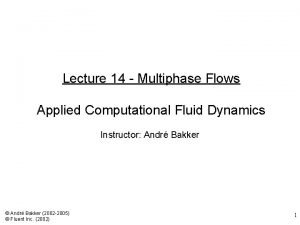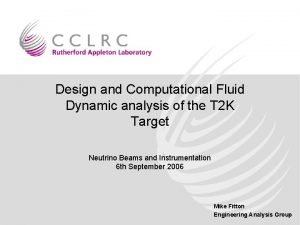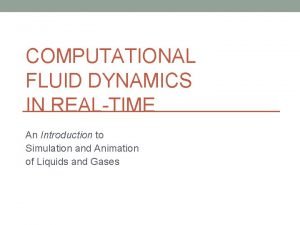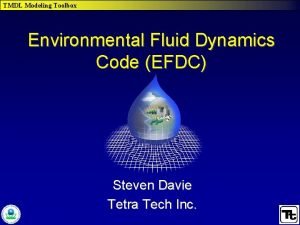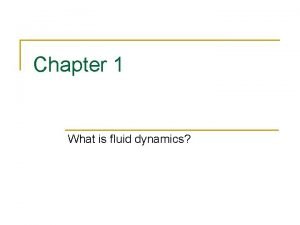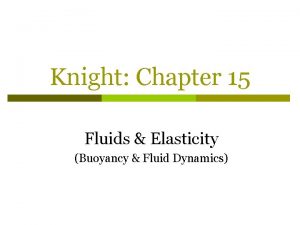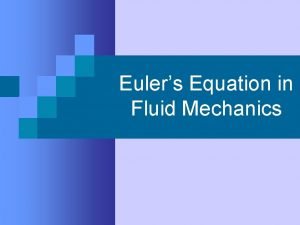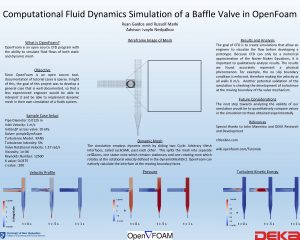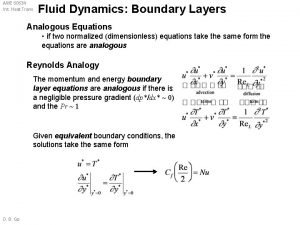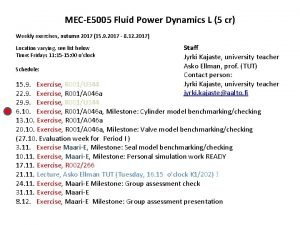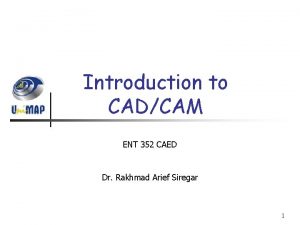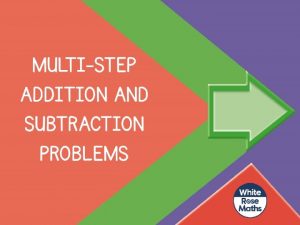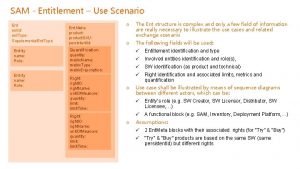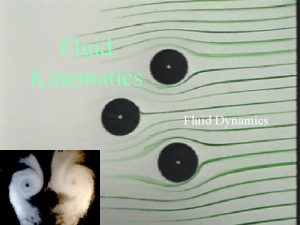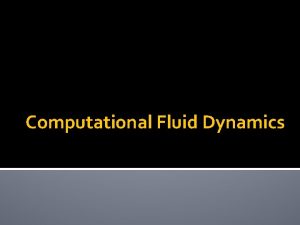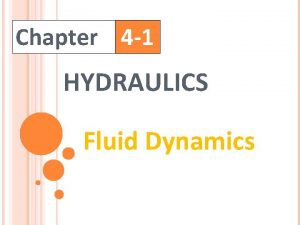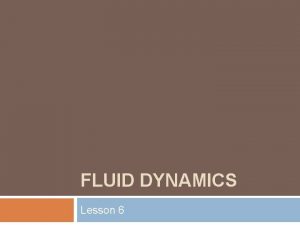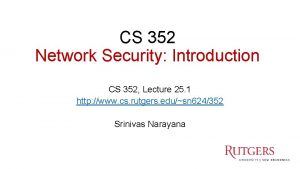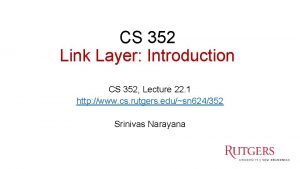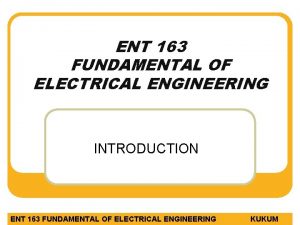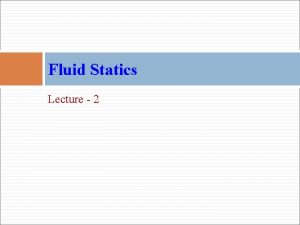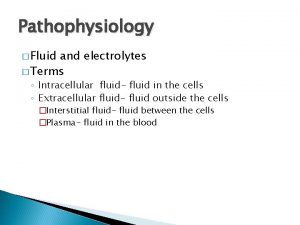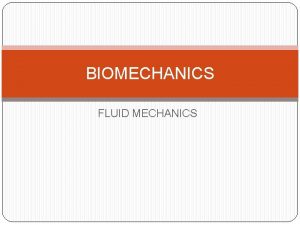Introduction to Computational Fluid Dynamics ENT 352 CAED























- Slides: 23

Introduction to Computational Fluid Dynamics ENT 352 CAED Dr. Rakhmad Arief Siregar 1

Introduction n Fluid (gas and liquid) flows are governed by partial differential equations which represent n n Conservation laws for the mass Momentum Energy Computational Fluid Dynamics (CFD) is the art of replacing such PDE systems by a set of algebraic equations which can be solved using digital computers. 2

What is fluid flow? n Fluid flows encountered in everyday life include n n n n meteorological phenomena (rain, wind, hurricanes, floods, fires) environmental hazards (air pollution, transport of contaminants) heating, ventilation and air conditioning of buildings, cars combustion in automobile engines and other propulsion systems interaction of various objects with the surrounding air/water complex flows in furnaces, heat exchangers, chemical reactors etc 3

What is fluid flow? n Numerical simulations of fluid flow (will) enable n n n n architects to design comfortable and safe living environments designers of vehicles to improve the aerodynamic characteristics chemical engineers to maximize the yield from their equipment petroleum engineers to devise optimal oil recovery strategies surgeons to cure arterial diseases (computational hemodynamics) meteorologists to forecast the weather and warn of natural disasters safety experts to reduce health risks from radiation and other hazards military organizations to develop weapons and estimate the damage 4

Examples of CFD applications Aerodynamic shape design 5

Examples of CFD applications 6

Examples of CFD applications 7

Experiments vs. Simulations n CFD gives an insight into flow patterns that are difficult, expensive or impossible to study using traditional (experimental) techniques 8

Experiments vs. Simulations n As a rule, CFD does not replace the measurements completely but the amount of experimentation and the overall cost can be significantly reduced. Equipment and personnel are difficult to transport CFD software is portable, easy to use and modify n The results of a CFD simulation are never 100% reliable because n n n the input data may involve too much guessing or imprecision the mathematical model of the problem at hand may be inadequate the accuracy of the results is limited by the available computing power 9

Fluid characteristics n The reliability of CFD simulations is greater n n n for laminar/slow flows than for turbulent/fast ones for single-phase flows than for multi-phase flows for chemically inert systems than for reactive flows 10

How does CFD make predictions? n CFD uses a computer to solve the mathematical equations for the problem at hand. The main components of a CFD design cycle are as follows: n n n the human being (analyst) who states the problem to be solved scientific knowledge (models, methods) expressed mathematically the computer code (software) which embodies this knowledge and provides detailed instructions (algorithms) for the computer hardware which performs the actual calculations the human being who inspects and interprets the simulation results CFD is a highly interdisciplinary research area which lies at the interface of physics, applied mathematics, and computer science 11

CFD analysis process n n n n n Problem statement Mathematical model Mesh generation Space discretization Time discretization Iterative solver CFD software Simulation run Postprocessing Verification n n information about the flow IBVP = PDE + IC + BC nodes/cells, time instants coupled ODE/DAE systems algebraic system Ax = b discrete function values implementation, debugging parameters, stopping criteria visualization, analysis of data model validation / adjustment 12

Problem statement n n n What is known about the flow problem to be dealt with? What physical phenomena need to be taken into account? What is the geometry of the domain and operating conditions? Are there any internal obstacles or free surfaces/interfaces? What is the type of flow (laminar/turbulent, steady/unsteady)? What is the objective of the CFD analysis to be performed? n n computation of integral quantities (lift, drag, yield) snapshots of field data for velocities, concentrations etc. shape optimization aimed at an improved performance What is the easiest/cheapest/fastest way to achieve the goal? 13

Mathematical model n n n Choose a suitable flow model (viewpoint) and reference frame. Identify the forces which cause and influence the fluid motion. Define the computational domain in which to solve the problem. Formulate conservation laws for the mass, momentum, and energy. Simplify the governing equations to reduce the computational effort: n n n use available information about the prevailing flow regime check for symmetries and predominant flow directions (1 D/2 D) neglect the terms which have little or no influence on the results model the effect of small-scale fluctuations that cannot be captured incorporate a priori knowledge (measurement data, CFD results) Add constitutive relations and specify initial/boundary conditions. 14

Discretization process n n The PDE system is transformed into a set of algebraic equations Mesh generation (decomposition into cells/elements) n n Space discretization (approximation of spatial derivatives) n n n structured or unstructured, triangular or quadrilateral? CAD tools + grid generators (Delaunay, advancing front) mesh size, adaptive refinement in ‘interesting’ flow regions finite differences/volumes/elements high- vs. low-order approximations Time discretization (approximation of temporal derivatives) n n explicit vs. implicit schemes, stability constraints local time-stepping, adaptive time step control 15

Iterative solution strategy n The coupled nonlinear algebraic equations must be solved iteratively n Outer iterations: the coefficients of the discrete problem are updated using the solution values from the previous iteration so as to n n n get rid of the nonlinearities by a Newton-like method solve the governing equations in a segregated fashion Inner iterations: the resulting sequence of linear subproblems is typically solved by an iterative method (conjugate gradients, multigrid) because direct solvers (Gaussian elimination) are prohibitively expensive Convergence criteria: it is necessary to check the residuals, relative solution changes and other indicators to make sure that the iterations converge. As a rule, the algebraic systems to be solved are very large (millions of unknowns) but sparse, i. e. , most of the matrix coefficients are equal to zero. 16

CFD simulations n The computing times for a flow simulation depend on n n n the choice of numerical algorithms and data structures linear algebra tools, stopping criteria for iterative solvers discretization parameters (mesh quality, mesh size, time step) cost per time step and convergence rates for outer iterations programming language (most CFD codes are written in Fortran) many other things (hardware, vectorization, parallelization etc. ) The quality of simulation results depends on n the mathematical model and underlying assumptions approximation type, stability of the numerical scheme mesh, time step, error indicators, stopping criteria 17

Postprocessing and analysis n Postprocessing of the simulation results is performed in order to extract the desired information from the computed flow field n n n calculation of derived quantities (streamfunction, vorticity) calculation of integral parameters (lift, drag, total mass) visualization (representation of numbers as images) n n n 1 D data: function values connected by straight lines 2 D data: streamlines, contour levels, color diagrams 3 D data: cutlines, cutplanes, isosurfaces, isovolumes, arrow plots, particle tracing, animations. . . Systematic data analysis by means of statistical tools Debugging, verification, and validation of the CFD model 18

Uncertainty and error n Whether or not the results of a CFD simulation can be trusted depends on the degree of uncertainty and on the cumulative effect of various errors n n Uncertainty is defined as a potential deficiency due to the lack of knowledge (turbulence modeling is a classical example) Error is defined as a recognizable deficiency due to other reasons n n n Acknowledged errors have certain mechanisms for identifying, estimating and possibly eliminating or at least alleviating them Unacknowledged errors have no standard procedures for detecting them and may remain undiscovered causing a lot of harm Local errors refer to solution errors at a single grid point or cell Global errors refer to solution errors over the entire flow domain Local errors contribute to the global error and may move throughout the grid. 19

Classification of errors n Acknowledged errors n n Physical modeling error due to uncertainty and deliberate simplifications Discretization error approximation of PDEs by algebraic equations n n n spatial discretization error due to a finite grid resolution temporal discretization error due to a finite time step size Iterative convergence error which depends on the stopping criteria Round-off errors due to the finite precision of computer arithmetic Unacknowledged errors n n Computer programming error: “bugs” in coding and logical mistakes Usage error: wrong parameter values, models or boundary conditions Awareness of these error sources and an ability to control or preclude the error are important prerequisites for developing and using CFD software 20

Verification of CFD codes n Verification amounts to looking for errors in the implementation of the models n n n Examine the computer programming by visually checking the source code, documenting it and testing the underlying subprograms individually Examine iterative convergence by monitoring the residuals, relative changes of integral quantities and checking if the prescribed tolerance is attained Examine consistency (check if relevant conservation principles are satisfied) Examine grid convergence: as the mesh and/or and the time step are refined, the spatial and temporal discretization errors, respectively, should asymptotically approach zero (in the absence of round-off errors) Compare the computational results with analytical and numerical solutions for standard benchmark configurations (representative test cases) 21

Verification of CFD codes n Verification amounts to looking for errors in the implementation of the models n n n Verify the code to make sure that the numerical solutions are correct. Compare the results with available experimental data (making a provision for measurement errors) to check if the reality is represented accurately enough. Perform sensitivity analysis and a parametric study to assess the inherent uncertainty due to the insufficient understanding of physical processes. Try using different models, geometry, and initial/boundary conditions. Report the findings, document model limitations and parameter settings. The goal of verification and validation is to ensure that the CFD code produces reasonable results for a certain range of flow problems. 22

Available CFD software ANSYS CFX FLUENT STAR-CD FEMLAB EFD FEATFLOW n n n http: //www. ansys. com http: //www. fluent. com http: //www. cd-adapco. com http: //www. comsol. com http: //www. flomerics. com http: //www. featflow. de commercial commercial open-source As of now, CFD software is not yet at the level where it can be blindly used by designers or analysts without a basic knowledge of the underlying numerics. Experience with numerical solution of simple ‘toy problems’ makes it easier to analyze strange looking simulation results and identify the source of troubles. New mathematical models (e. g. , population balance equations for disperse systems) require modification of existing / development of new CFD tools. 23
 Computational fluid dynamics
Computational fluid dynamics Computational fluid dynamics
Computational fluid dynamics Cern alice
Cern alice Computational fluid dynamics
Computational fluid dynamics Computational fluid dynamics
Computational fluid dynamics Computational fluid dynamics
Computational fluid dynamics Computational fluid dynamic
Computational fluid dynamic Synovial membrane
Synovial membrane P1-p2
P1-p2 Fluid statics deals with fluid at rest
Fluid statics deals with fluid at rest Intracellular fluid and extracellular fluid examples
Intracellular fluid and extracellular fluid examples Ecf icf and interstitial fluid
Ecf icf and interstitial fluid Interstitial vs intracellular
Interstitial vs intracellular Fluid mechanics chapter
Fluid mechanics chapter Movement of body fluids
Movement of body fluids Ascitic fluid examination
Ascitic fluid examination Fluid dynamics animation
Fluid dynamics animation Environmental fluid dynamics code
Environmental fluid dynamics code Fluid dynamics definition
Fluid dynamics definition Fluid dynamics
Fluid dynamics Euler's equation
Euler's equation Fluid dynamics
Fluid dynamics Fluid dynamics
Fluid dynamics Fluid power dynamics
Fluid power dynamics
